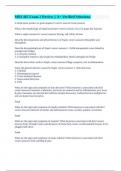MBI 405 Exam 2 Review || A+ Verified Solutions.
Is Staph gram positive or gram negative? correct answers Gram positive
What is the morphology of Staph bacterium? correct answers Cocci in grape like bunches
What is staph resistant to? correct answers Drying, salt (10%), & heat
Describe the temperature and pH preferences of Staph. correct answers Mesophilic and
MesopHilic
Describe the peptidoglycan of Staph. correct answers 1. NAM-tetrapeptides cross-linked by
pentaglycine bridges
2. Lysozyme-resistant
3. Lysostaphin-sensitive; glycyl-glycine endopeptidase attacks pentaglycine bridge
Describe the teichoic acids in Staph. correct answers Phage receptors; role in inflammation
Name the general diseases caused by Staph. correct answers 1. Skin abscesses
2. Cellulitis
3. Hematogenous spread
4. Toxin-mediated diseases
5. Nosocomial Infections
6. UTIs
What are the signs and symptoms of skin abscesses? What bacteria is associated with this?
correct answers Furuncles, carbuncles, and styes are characterized by inflammation, pus, fever,
& pain. Furuncles are infected hair follicles (simple abscesses). Carbuncles have multiple foci
and are deeper than furuncles.
Staph
What are the signs and symptoms of (staph) cellulitis? What bacteria is associated with this?
correct answers Infection of dermis and subcutaneous tissue, swollen, painful, red streaks
Staph
What are the signs and symptoms of mastitis? What bacteria is associated with this? correct
answers Entry through cracks and abrasions of breast fatty tissue, swollen/painful breasts, fever,
plugged milk ducts
Staph
What are the signs and symptoms of septic arthritis? What bacteria is associated with this?
correct answers Joint swelling & pain
,Staph
What are the signs and symptoms of osteomyelitis? What bacteria is associated with this? correct
answers Bone abscess
Staph
What are the sources of infection for staph? correct answers 1. Normal human microbiota
2. Animals
3. The environment
Describe the transmission of staph. correct answers -Hand-to-hand contact with other people
-Food handlers to food (>60C for 60 min to kill)
-Aerosols from pneumonia patients/dust/curtains
-Catheters
-Syringes
Describe the MO of Staph correct answers ENTRY: via endogenous or exogenous microbiota
through cuts, wounds, burns, catheters
ATTACHMENT: To fibronectin, laminin, collagen
MSCRAMMS (microbial surface components recognizing adhesive matrix molecules)
MULTIPLIES: in situ, acquiring nutrients with lipases, DNase, protease
EVADES: By hiding via capsule, protein A coagulase
KILLS: Shifts by employing quorum sensing to shift from binding to toxin production
Name the adhesin virulence factors associated with Staph correct answers 1. MSCRAMMs: bind
fibronectin, collagen, laminin
2. Intercellular adhesin proteins: binds plastic
3. Teichoic acid: binds fibronectin, activates C'
Name the evasin virulence factors associated with Staph correct answers 1. Polysaccharide
capsule: anti-phagocytic
2. MSCRAMMs: masking by binding matrix
3. Catalase: H2O2 -->H2O + O2
4. Coagulase: activates prothrombin ... thrombin + fibrinogen -> fibrin clot, hide
5. Fatty acid modifying enzyme: nutrients, inactivates antibacterial lipids
6. Lipases: Nutrients, hydrolyze lipids
7. DNase: nutrients, dissolves released DNA
8. Transferrin binding protein A: transferrin binding
9. Iron regulated surface determinant: hemoglobin binding & heme uptake
Name the invasin virulence factors associated with Staph correct answers 1. Staphylokinase:
activates plasminogen -> plasmin (fibrolysin)... dissolves clots to spread
2. Hyaluronidase: protease, helps spread by damaging connective tissue
3. Aureolysin: protease, helps spread by inactivating ClfB (clumping factor)
, Name the toxin virulence factors associated with Staph correct answers 1. LTA, CWfragments:
activate C' leads to inflammation/shock
2. Hemolysins
-Alpha toxin: damages PMN, RBC membranes
-Beta toxin: sphingomyelinate C
-Delta toxin: RBCs, WBCs, platelet
3. Synergohymenotropic (SHT) toxin: beta barrel pore former, Ca2+ influx, cell activation
-Bicomponent toxins (S and F)
-S = Slow eluting: in host cell membrane
-F = Fast eluting: forming a pore
4. Exfoliative toxins: skin sloughing
5. Superantigens: polyclonal T cell activation
6. Staphylococcal enterotoxins (SE):Stimulates vagus nerve to vomit, histamine and leukotriene
release from mast cells to cause diarrhea, inhalational
7. Toxic Shock Syndrome Toxin: causes a cytokine storm, rash
Explain virulence gene regulation of Staph correct answers -Quorum sensing: adhesins early,
toxins later, AgrD is the autoinducer which stimulates a regulatory cascade to produce RNAIII to
both down regulate MSCRAMMs/protein A & downregulates Rot (toxin repressor)
What are the signs and symptoms of bullous impetigo? What bacteria is associated with this?
correct answers Localized exfoliation, thin-walled abscesses that look like blisters
Staph
What are the signs and symptoms of scalded skin syndrome? What bacteria is associated with
this? correct answers Seen in infants, exfoliation of skin so it becomes wrinkly & dry, high
mortality if left untreated
Staph
What are the signs and symptoms of Toxic Shock Syndrome? What bacteria is associated with
this? correct answers -Rapidly rising fever
-Vomiting & diarrhea
-Sore throat
-Myalgia (muscle pain)
-Exfoliation/rash
-Hypotension/shock
What occurred in the lats 1970s to cause an outbreak of TSS? correct answers Women began to
use super-absorbant Rely tampons. These tampons were a recipe for disaster due to:
-Tampon increased O2 level
-Menses increased pH and protein
-High absorbancy meant less frequent changing




